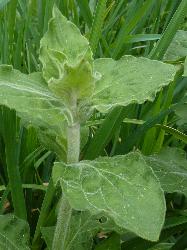- Taxon
- Gallery
- ≡ Lychnis dioica L. (1753)
- ≡ Melandrium dioicum (L.) Coss. & Germ. (1861)
- = Lychnis diurna Sibth. (1794)
- ≡ Melandrium diurnum (Sibth.) Fr. (1842)
- = Silene diurna Gren. & Godr. (1847)
- ≡ Melandrium rubrum (Weigel) Garcke (1858)
- = Lychnis dioica subsp. rubra Weigel
Taprooted perennial. Stems unbranched or branched below, with soft eglandular hairs, also becoming glandular above, (15)–30–60–(80) cm tall. Lvs with soft eglandular hairs, green, lanceolate to ovate, acute to acuminate, long-petiolate, becoming sessile above; lamina (2)–3–6–(10) × (1)–1.5–3–(4) cm. Infl. a (3)–7–10–(20)-flowered dichasium, sometimes unequally branched; pedicels 0–1–(2) cm long; bracts lanceolate to ovate, acuminate, green. Fls unisexual. Calyx with short to long glandular and eglandular hairs: in ♂ weakly 10-veined, cylindric, 10–14 mm long; in ♀ weakly 20-veined, ovoid, 12–15 mm long; teeth triangular-acuminate, erect or recurved. Petals pink to magenta; limb 2-fid; claw lobed at base of limb; coronal scales oblong, toothed at apex, 1.5–2 mm long in ♂, 1 mm long in ♀. Styles 5, erect or recurved at apex, 9–11 mm long. Capsule globose to broadly ovoid, included within or = calyx, 10–15 mm long, dehiscing by 10 revolute teeth; carpophore very short. Seeds dull dark brown to grey, reniform, rounded, bluntly warty, 1.2–1.4 mm long.
[From: Webb et al. (1988) Flora of New Zealand. Volume 4.]
Flowering: Dec.–Jan.–(Apr.); Fruiting: Dec.–Feb.




